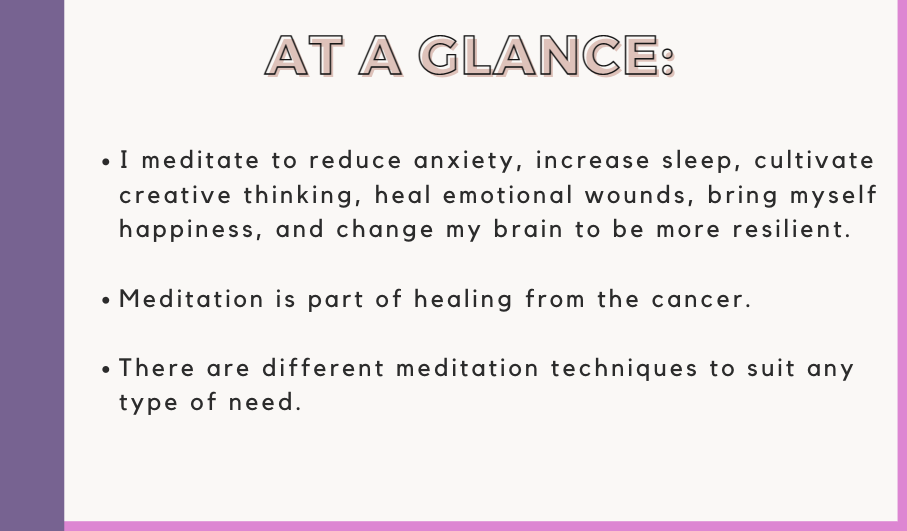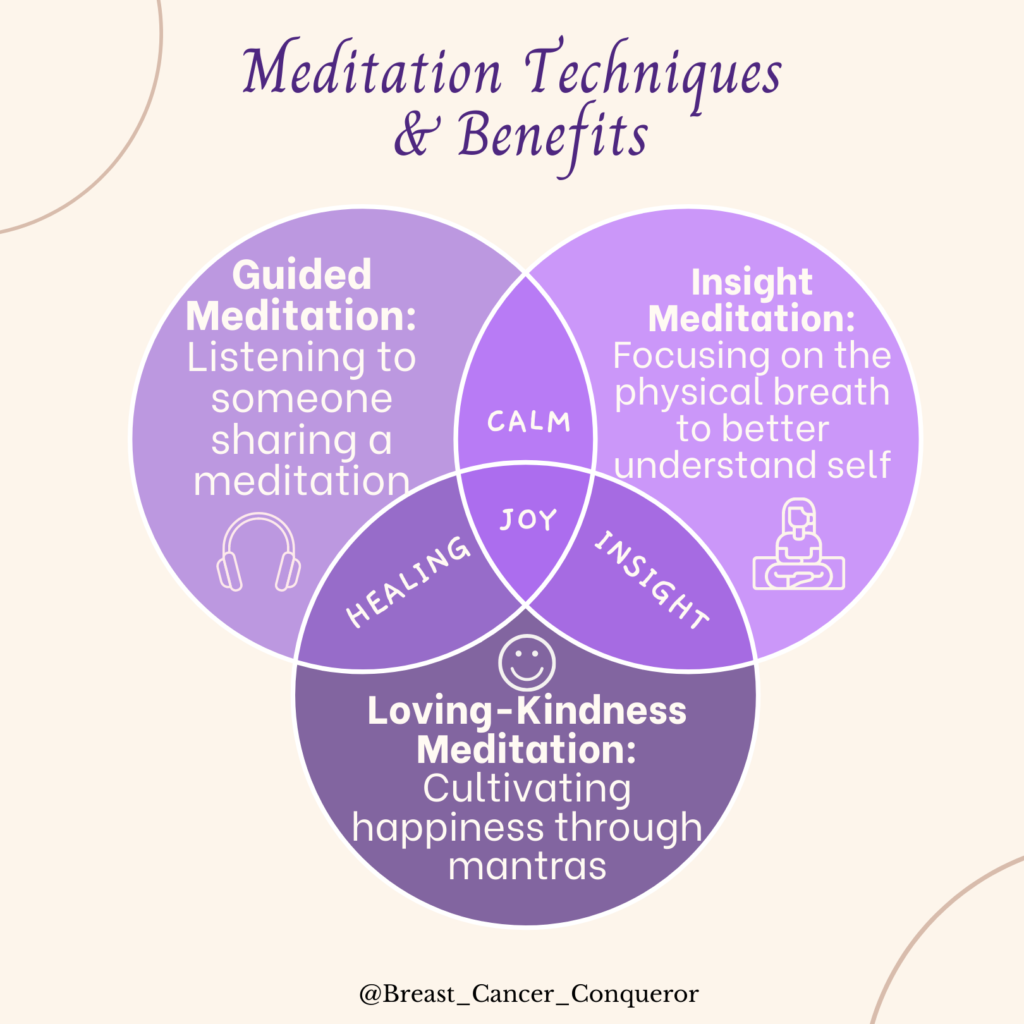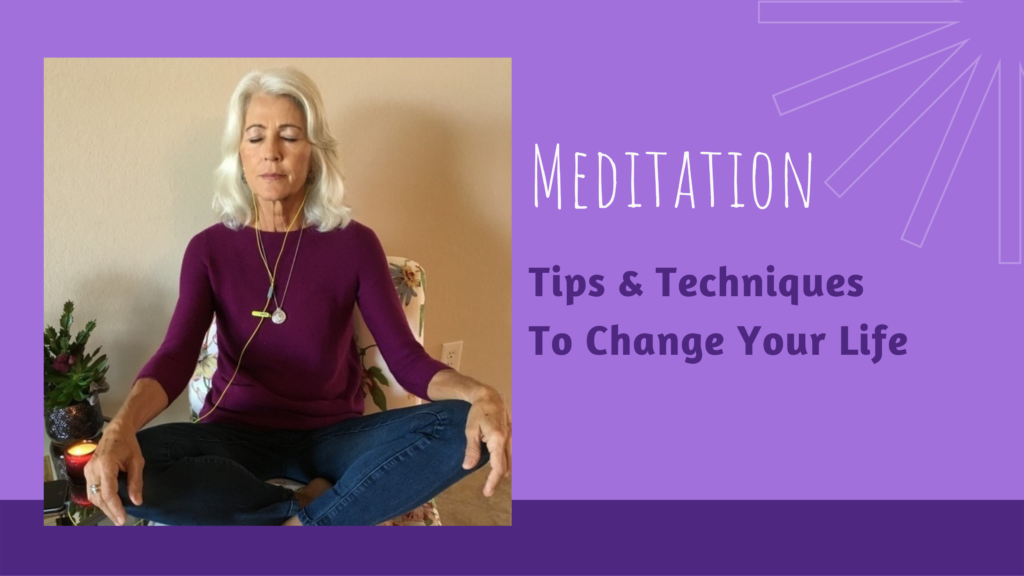
The phrase “meditating is good for you” isn’t new information. I am sure you have heard it countless times from your girlfriends, from this community, an ad that just popped up, and hopefully even your doctors. But is sitting still and being quiet all it is cracked up to be? Is there any science behind it, or is it just practiced by a fringe minority of hippie-dippie people?
You are in the right place if you ask those questions, contemplate meditating, or even dabble in it. Read on as we breathe and go deeper into science-based meditation techniques, insight, and tips to empower you to build an actual meditation routine. I will also share the meditations I use and how to let your practice flow into all aspects of your day (and rejuvenating sleep!).
Why do I meditate?
First, I want to share with you a few reasons why my meditation practice is at the top of my to-do list every single day. 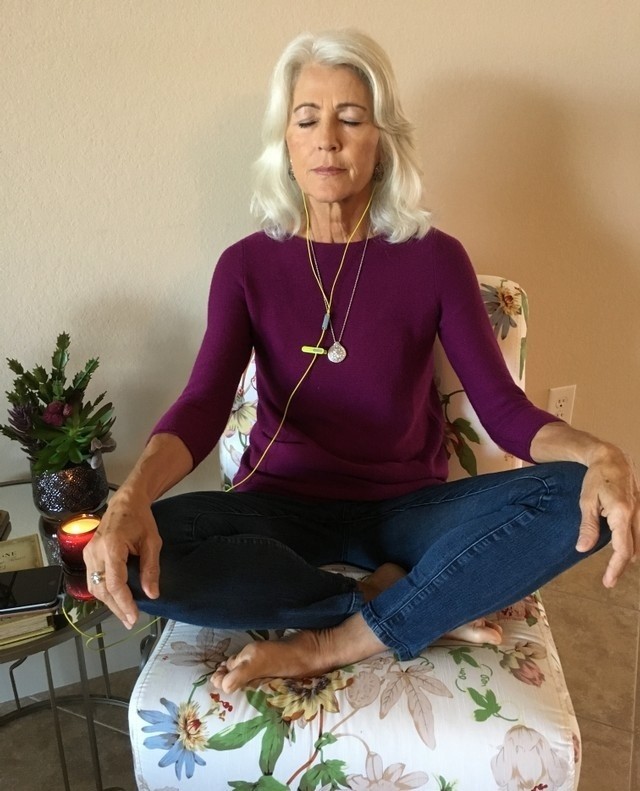
- Reduces anxiety and increases sleep. Breast cancer, pandemic life, kids, marriage, careers – all of this can lead to anxiety creeping into every little detail of our lives. Meditation helps me manage my inner self and, therefore, my anxiety, resulting in much better sleep, health, happiness, and healing from cancer.
- Cultivates creative thinking. When I take a moment to be still, flush out my stress, and truly connect with myself – I tap into my full potential.
- Heals emotional wounds. Daily meditation helped me get into a headspace where I could start healing the emotional wounds that were part of initiating cancer in the first place.
- Brings happiness. People who have meditated for years have a larger left prefrontal cortex, the part of the brain responsible for happiness.
- Changes the brain’s neuroplasticity to promote healing. I have read countless studies about brain scans showing how meditation changes the regions of the brain that support our memory, resiliency to stress, empathy levels, and so much more. Curious? Read on.
- Calms the Nerve System and stimulates the Relaxation Response. Staying in a fight or flight mode has been shown to increase the spread and growth of cancer, so it is vital to calm down your nervous system every day.
Mediation is so important that I included it as part of the 7 Essentials System® and wrote at length about it in my book, Heal Breast Cancer Naturally.
Meditation And Breast Cancer
Let’s actually “do the work” together. Take a moment to pause. It doesn’t matter where you are, takes a big breath and let everything out – aaahhhhhhhayy! Now, visualize your immune system successfully removing unhealthy cells. Take another refreshing breath and see your future self as healthy, whole, vibrant, and taking care of your well-being with intention. Inhale – Exhale. Feel the feelings. Bring the emotions to life. Visualize in Technicolor.
You don’t have to spend hours a day or know all of the meditation techniques. Research has shown that even just 1 minute (but 15-20 minutes is more effective) of any type of meditation can profoundly change your brain, mind, and soul. Our brain’s neuroplasticity can be re-wired for improved levels of happiness and calm – leading to better sleep and a stronger immune system. Take a moment to practice this: visualize a positive outcome of your journey and see and feel your body as healthy, whole, and complete.
For women on a healing journey with breast cancer, dozens of studies that I have read have similar conclusions to this study. “Meditation has shown positive effects in reducing physical and emotional symptoms such as psychological stress, depression, anxiety, fatigue, fear of recurrence and rumination, representing an efficient strategy for coping with the disease and improving quality of life.”
Meditation is also part of feeding a healthy adrenal system. Your levels of stress and sleep directly correlate to healthy or unhealthy adrenal glands. Take a moment to learn about your adrenal health and breast cancer in this blog.
Meditation works. Inhale – Exhale. Now, let’s go deeper.
Meditation Techniques To Explore
You are unique, ever-changing, and wonderful. Your meditation practice can also mirror these traits, as it is a part of you. But – we are also busy-minded people with packed calendars. I get it. However, even the busiest person has time for their emotional, mental, and physical healing and prevention of future diseases.
Below are some different ways to meditate and how each can help you stay in a calm state. Yes, meditation is focusing on your breath and going inward, but it isn’t just that. There are endless paths to meditation, ways to heal, and techniques to train your awareness and compassion. Let’s also be realistic – some of us get easily distracted, our bodies get fidgety, and our ears can’t block out the noise of the world or our bodies. Please keep reading to find meditation techniques and tips to help you turn them into daily practice. In a short time, you will start to see the benefits that carry into your everyday life. That being said, everyone should try all sorts of meditation practices since only positive developments will come from each.
Guided Meditation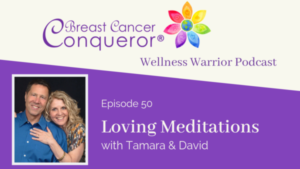
- Why choose guided meditation? They are like having a meditation guru speaking guiding words so that you can let your mind enter a flow state as you follow their guidance. You can find guided meditation for practically anything you want to achieve.
- Who should do this? Beginners and people who get easily distracted meditating on their own would benefit from someone guiding them. They can be as short or as long as you want.
- Try it today! Loving Meditations are guided meditations for people on a healing journey. We often forget that our caregivers and support system also need some downtime. Listen to my podcast interview with the founders and click here for a free month of their premium content!
Insight Meditation
- Why choose Insight Meditation? It is the oldest of meditation practices. Today, people swear by its mind-body benefits of providing a sense of awakening and security at the same time. It is rooted in the fact that we have the capacity to overcome our pain, impulses, and personal conflicts.
- Who should try this? A person who wants to start better understanding their thought patterns to grasp why they think the way they do. It is also helpful for those who have difficulty focusing on one thing at a time – for someone who needs something physical to focus on.
- Try it today! Find a quiet place so that you can actually hear and feel your own breath as it is the anchor of this practice. Then put your hand on your abdomen and focus on the rising and falling of the belly while silently counting each in-breath and out-breath. When a distraction enters your mind (a memory, to-do list plan, smell, etc.) enters your mind, simply note it and then shift back to focusing on just your breath.
Loving-Kindness Meditation
- Why choose loving-kindness meditation? A daily practice of kindness is a direct path to happiness and more satisfaction in your life.
- Who should try this? The person who wants to cultivate more happiness and a deeper connection with the world around them. This practice also includes focusing on a specific word like joy, love, or peace. Repeating a specific word can help keep you stay focused while changing your mind’s thoughts about a particular part of yourself, life, and the world around you.
- Try it today! Click here for 15-minute audio and written guide of the mantras to say during this type of meditation.
Inhale – Exhale.
You don’t need to be an expert to create techniques that work for you. You are your body and know what it truly needs. Is there a phrase such as “you are strong enough” that would be helpful to repeat during meditation, or whenever is needed in your day, to remind your body and brain of what you truly can accomplish? Is there a prayer that it is your heart that you can say out loud or silently? Perhaps you can visualize healing light -positivity coming in and negativity flowing out. You could also visualize specific moments of your future, such as doing an activity you love with your family and feeling totally healthy. The point is you are the master of your meditation. Be creative – flow into the life you want.
Where Can I Find Meditations?
You can meditate anywhere and everywhere – for free! However, there are endless resources to remind you to meditate, guide you, and so much more. Some of the resources I suggest are:
- Headspace.com is an app founded by a man who studied meditation across the world for over 10 years. He created this app to make meditation more mainstream. Headspace is proven to reduce stress by 14% in just 10 days.
- Loving Meditations is created especially for cancer patients and their caregivers to dramatically reduce stress, anxiety, pain, and discomfort through their medical ordeal.
- The Tim Janis Youtube channel is perfect for those of you living in a concrete jungle as it provides gorgeous videos of nature and calming sounds that he composes each week. I often use this during my unguided meditations.
- The Louise Hay Youtube channel is a wonderful channel for guided meditations and brilliant words about healing.
- HeartMath Inner Balance App has been at the forefront of the most advanced research regarding stress and your Heart Rate Variability (HRT) for over 30 years! Inner Balance measures your HRT (your body’s stress responses) to see if you are in Fight or Flight mode. Use this information to breathe “through your heart” as you focus on positive feelings such as joy, gratitude, and peace. You can literally “see” how your nervous system responds as you get into relaxation mode.
Do you know that famous phrase “Keep calm & carry on”? Let that be your focus this year – just keep calm through meditation. Inhale – Exhale – Awwww!
